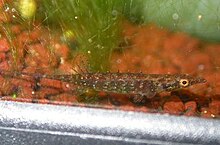| Indostomus | |
|---|---|

| |
| I. paradoxus in an aquarium | |
| Scientific classification | |
| Domain: | Eukaryota |
| Kingdom: | Animalia |
| Phylum: | Chordata |
| Class: | Actinopterygii |
| Order: | Perciformes |
| Suborder: | Gasterosteoidei |
| Family: | Indostomidae Prashad & Mukerji, 1929 |
| Genus: | Indostomus Prashad & Mukerji, 1929 |
| Type species | |
| Indostomus paradoxus Prashad & Mukerji, 1929 | |

Indostomus is a genus of small fishes native to slow moving or stagnant freshwater habitats in Indochina. It is the sole genus of the monogeneric family Indostomidae, Long considered to be sticklebacks, within the order Gasterosteiformes, modern analyses place the Indostomids within the order Synbranchiformes, related to the spiny eels and swamp eels.
Taxonomy
Indostomus was first proposed as a genus in 1929 by the Indian zoologists Baini Prashad and Dev Dev Mukerji when they described Indostomus paradoxus, giving its type locality as north of the Indawgyi Lake near Nyaungbin in Upper Burma. As the same time they also classified this new genus in the new monotypic family Indostomidae. Indostomidae was classified within the order Gasterostiformes, placed in the suborder Gasterosteoidei. Phylogenetics have, however, shown that Gasterostiformes was paraphyletic with the Gasterosteoidei not being sister to the Syngnathoidei and being more closely related to the Zoarcoidei, but that the inclusion of the Indostomidae in the Gasterosteoidei rendered that taxon paraphyletic. However, in the 5th edition of Fishes of the World Indostomidae was still included in the Gasterosteoidei within the order Scorpaeniformes but other phylogenetic studies have classified the family within the monotypic suborder Indostomoidei within the order Synbranchiformes.
Description

Indostomus species are all incredibly small, on average reaching 3 cm in length at maximum. Their bodies are armored and thin, tapering towards the back, and ending in a small, fan-shaped tail. They are sexually dimorphic, with mature females outwardly showing the presence of eggs with a broader, fuller abdomen, and, in the case of Indostomus crocodilus, mature males have white bands along the edges of the dorsal, anal, and ventral fins.
Habitat
Indostomus species show a clear preference for slow moving and stagnant freshwater wetlands, streams, ponds, and oxbow lakes, including both clearwater and blackwater habitats. Indostomus are often found around aquatic plant growth, algae, and decaying organic material such as leaf litter and branches. Sympatric fishes include danionins, Dario, and gouramis.
Behavior and Diet
Indostomus are micropredatory fish, predating on small aquatic insects, crustaceans, and worms. In an aquarium setting, Indostomus will often refuse prepared foods, only eating very small live or frozen foods such as copepods, Artemia, Daphnia, or Moina.
Indostomus will spawn in very small caves and crevices, such as in reeds, bamboo, or very small lengths of plastic piping. Individual males will select a spawning site, and guard the eggs and nest until the fry are free swimming and disperse.
Species
The three currently recognized species in this genus are:
- Indostomus crocodilus Britz & Kottelat, 1999
- Indostomus paradoxus Prashad & Mukerji, 1929 (armoured stickleback, pipe fish)
- Indostomus spinosus Britz & Kottelat, 1999
Indostomus paradoxus, was discovered in the 1920s in Lake Indawgyi in Myanmar. In the 1990s, two other species were discovered and placed into the genus Indostomus. Indostomus crocodilus from Thailand, and Indostomus spinosus from Mekong River basin. In 2001, I. tiliosi was listed as a possible new species, but has not yet been officially described.
References
- Froese, Rainer; Pauly, Daniel (eds.). "Family Indostomidae". FishBase. October 2012 version.
- ^ Kawahara, Ryouka; Miya, Masaki; Mabuchi, Kohji; Lavoué, Sébastien; Inoue, Jun G.; Satoh, Takashi P.; Kawaguchi, Akira; Nishida, Mutsumi (2008). "Interrelationships of the 11 gasterosteiform families (sticklebacks, pipefishes, and their relatives): A new perspective based on whole mitogenome sequences from 75 higher teleosts". Molecular Phylogenetics and Evolution. 46 (1): 224–236. doi:10.1016/j.ympev.2007.07.009. ISSN 1055-7903. PMID 17709262.
- ^ Ricardo Betancur-R; Edward O. Wiley; Gloria Arratia; et al. (2017). "Phylogenetic classification of bony fishes". BMC Evolutionary Biology. 17 (162): 162. doi:10.1186/s12862-017-0958-3. PMC 5501477. PMID 28683774.
- Eschmeyer, William N.; Fricke, Ron & van der Laan, Richard (eds.). "Genera in the family Indostomidae". Catalog of Fishes. California Academy of Sciences. Retrieved 24 November 2022.
- Eschmeyer, William N.; Fricke, Ron & van der Laan, Richard (eds.). "Species in the genus Inostomus". Catalog of Fishes. California Academy of Sciences. Retrieved 24 November 2022.
- Richard van der Laan; William N. Eschmeyer & Ronald Fricke (2014). "Family-group names of Recent fishes". Zootaxa. 3882 (2): 001–230. doi:10.11646/zootaxa.3882.1.1. PMID 25543675.
- J. S. Nelson; T. C. Grande; M. V. H. Wilson (2016). Fishes of the World (5th ed.). Wiley. pp. 467–495. ISBN 978-1-118-34233-6. Archived from the original on 2019-04-08. Retrieved 2022-11-24.
- "Indostomus crocodilus — Seriously Fish". Retrieved 2021-10-09.
- Froese, Rainer; Pauly, Daniel (eds.). "Species in genus Indostomus". FishBase. October 2012 version.
- Britz, R. and M. Kottelat. (1999). Two new species of gasterosteiform fishes of the genus Indostomus (Teleostei: Indostomidae). Ichthyol. Explor. Freshwat. 10(4):327-336.
Further reading
- Berra, Tim M. (2001). Freshwater Fish Distribution. San Diego: Academic Press. ISBN 0-12-093156-7
| Taxon identifiers | |
|---|---|
| Indostomus | |